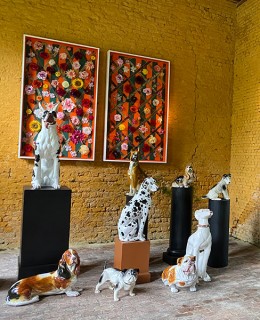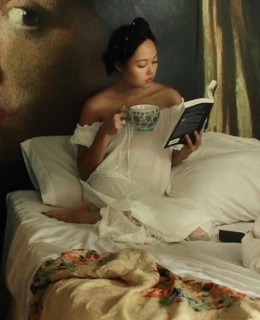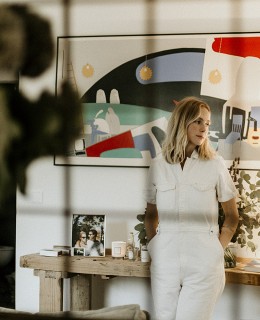It’s safe to say many people would give anything for a change of scenery right now. I, for one, wouldn’t mind being teleported into a velvet conversation pit amidst a sea of flowers, nor have a much-needed nap in a sparkling rosé pool where lazy trees shield me from the burning sun. In fact, book me a vacation anytime in the fantastical world of Alexis Christodoulou, the South-African 3D-artist who is behind some of the internet’s dreamiest landscapes.
Escapism is booming in times like these and the upcoming movement of dreamscapes is there to feed it. Whimsical landscapes, blurring fantasy with reality and then mixing that with a high level of design, are popping up all over social media. I tracked down the man behind the most beautiful of them all and ended up calling a South-African winemaker with both a very busy and very creative schedule. Besides producing sparkling wine, Alexis Christodoulou -aka @teaaalexis– is a copywriter and self-taught 3D-artist. The latter started out as a hobby over six years ago, but became more once he realized how deliciously irrational it allowed him to be. I had some questions for the man whose art is an accidental manifesto against the overthinking of stuff:
How did 3D-design enter your life?
I kind of grew up with it. My generation was the first to enjoy cartoons and videogames digitally representing scenery in three dimensions. Most of those games were set in sci-fi or war-like worlds: not really the aesthetics I’m after but still, it got me thinking about what could possibly be done within this field.
Can you name some videogames with interesting aesthetics?
There was one called Beneath The Steel Sky when I was young, it had brutalist elements in it, almost fascist. Journey, a more recent game, is really quite beautiful. It’s like an open-world exploration game. Unfortunately, I don’t have much time to play right now.

How do you start working on your landscapes?
Initially I was heavily reference-based: I would try to recreate photos or drawings or collages I had made. Whereas now it has morphed into something that is frankly quite difficult to explain! [laughs] I’d say it’s a more intuitive process now. I look at moodboards, pictures and drawings I make, then I build up some aesthetic in my head and start creating without really having a plan. From there on, something just comes out and I see where it leads. My work also depends on the evolution of my skill set. In fact you can consider my Instagram page to be a sketchbook of every new skill I have learned. When I started for instance, I wasn’t really good at making natural elements so I wasn’t comfortable using them, while nowadays nature is omnipresent.
Don’t you ever want to build one of your designs in real life?
That is not the initial impulse. I’m not sure I want my images to be real, in fact: I like that they aren’t, that they cannot be accessed. That is the whole point: as soon as you create something for real, you destroy the fantastical element.
Sometimes people do it in my stead and proudly send me pictures of the result, thinking it will please me. Some are bad, others are OK, but none seemed to think they should have included me in the process. I learned social media is a double-edged sword in that way: people just take your idea and use it for their own gain, but there is no point in getting uptight about it.

Is there a message in your work?
No. I started creating to do something that was completely devoid of any kind of rationale and context. All my other creative pursuits, such as writing, require continued reasoning behind every detail, so this is me trying to do something that comes naturally rather than trying to portray some message. It’s a very freeing way of working, although as my work evolves, even I can see there are some regular elements in it.
Such as the total absence of humans, although their presence is often suggested…?
True, I have only put one human in my work up until now, and I did it reluctantly for a client. There are two reasons for it: first of all, by putting a person in the picture you create an automatic gaze and that again creates too much context. Also, I think 3D-people look ugly [laughs].
And what about animals?
Well, there you have it: I never even thought of putting an animal in there! Maybe one day, if I suddenly get really skilled at creating them…
There are a lot of pools though, should I have crazy expectations about your own backyard?
Ha ha no, I live in an apartment in Cape Town! We do have beautiful tidal pools around the city though, which I love although they are freezing. Also: water and natural light are really the easiest things to render in 3D…

Do you create every detail in the picture yourself, or are they derived from real images?
They are always actual 3D-models: I do create many myself, but sometimes I also source them on specialized databases.
3D-art seems to be having a moment, how will it evolve?
More and more so, yes. It’s a constantly evolving field. It is the current infantile state of the art which makes it interesting: 3D-artists are exploring different subjects and mediums that painters, and later photographers, have been exploring for hundreds of years. There is a new breed of artists representing classical subjects in their own ways. You can’t find tons of thought leaders within that group yet, but I guess at some point there will be a turning point: when this whole 3D-design thing will become easier to create, and it will, it will also require people with a vision to make it look really good; and they willrefine the whole movement. True artists will have to stand up then, and that’s where it will get interesting.

Has this whole crisis inspired you to create even more dreamy worlds?
I wish it was so. I wish it was an inspirational beacon, and that I was using this time to make my most promising and evocative worlds. In truth though, it’s the complete opposite. I’m just walking around, staring out of the window, not sleeping, figuring out how to exercise, having a slightly existential crisis. I think it’s completely normal to struggle, even for creatives these are really disruptive times, and that is just fine.
Which books would keep you busy?
I’ll give you my wish list: SuperStudio, Life Without Objects by Peter Lang and Menking. It’s a seventies architectural movement that has inspired my early work, with a lot of tiles and black & white grids. Also Handcrafted Modern by Leslie Williamson: I love her books at the moment, although they’re the complete opposite of the kind of environments I build. Her photographs look really alive with beautiful objects and a lot of texture. I’d also say some David Foster Wallace essays wouldn’t hurt because they’re quite funny and light-hearted. He had a nice way of looking at the world.





















